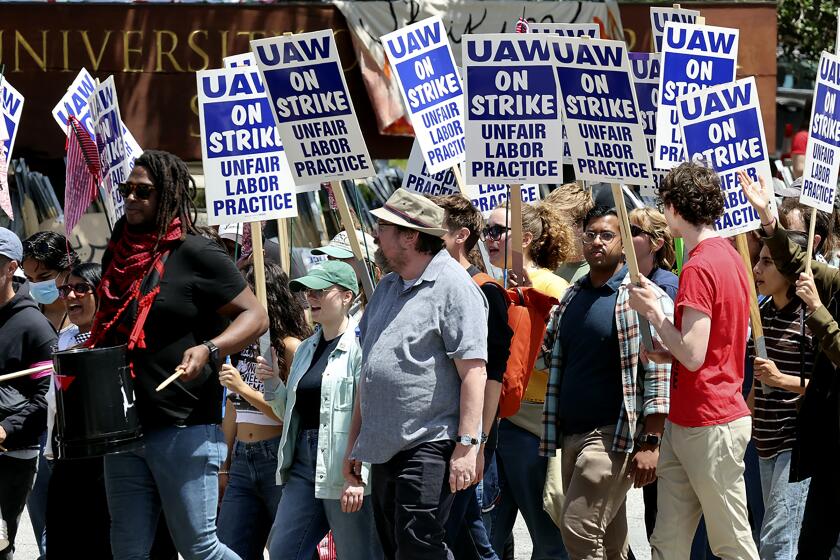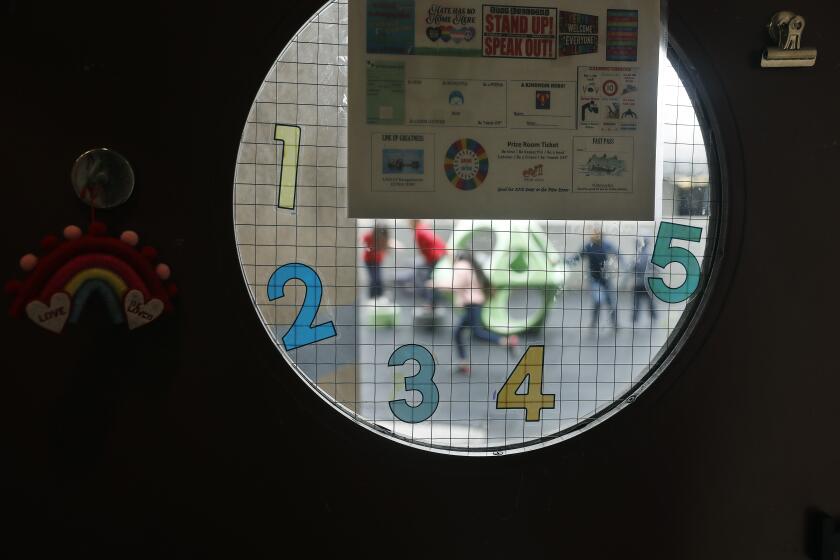Pierce College Enrollment Down 10% for Spring : Education: About 30% fewer new students registered this semester. Mission campus also reports a drop.
In recent years, the start of a new semester at Pierce College has meant long lines of students waiting hours to enroll in classes that often were already filled.
But the week before the spring semester this year, lines were short and many classes were still open. New students--unlike past students who were given appointments to register after completing admission forms--were being sent directly to the school’s registration center.
“It’s been about a 15-minute wait,” said William Norlund, the college’s vice president of academic affairs.
Easier and quicker enrollment may be good news for students, but the absence of the traditional long lines has college administrators puzzled and concerned. With classes starting today, the Woodland Hills campus has enrolled about 30% fewer new students than it had at the same time last year.
“Continuing students came back in higher percentages than normal through mail-in registration,” Norlund said. “But the new students aren’t there.”
As of Friday, overall enrollment at Pierce was down 10%, officials said. Last year, the college had registered about 18,000 students the week before the spring semester. This year, Norlund estimated, the number was closer to 16,000.
The two other San Fernando Valley campuses in the Los Angeles Community College District also reported slight decreases in enrollment. Mission College had enrolled about 500 fewer new students than expected, said Carlos Nava, dean of students. The total enrollment at the Sylmar campus was down by about 700.
At Valley College in Van Nuys, where some 15,600 students had completed registration as of last week, enrollment of both new and continuing students was only slightly down, said Marilyn Moy, dean of admissions.
Districtwide, records last week showed that enrollment was down 6.9%, compared with the same time last year.
Fausto Capobianco, district spokesman, said one reason Valley may have fared better than Pierce and some other campuses in attracting new students is because Valley “triggered a very aggressive direct-mail campaign” in the surrounding community after President Mary Lee anticipated that there might be a problem.
Classes at College of the Canyons and Antelope Valley College begin a week later than those in the Los Angeles district, and it was too early for officials to assess enrollment trends. But both colleges, which are in fast-growing areas, were expected to continue a five-year upward spiral in enrollment.
At Pierce, Norlund attributed the decrease in new students to three factors--higher student fees effective this semester, a previous lack of available classes and an earlier start date.
For the first time in a spring semester, classes began two weeks earlier as part of a district effort to conform with state university schedules. Students “might not have gotten the word,” Norlund said.
“We’ve had problems offering enough classes that new students have to take, such as history and math,” Norlund added. “Students may not be coming here because they don’t expect to get the classes they want.”
Unlike in past years, many classes, including history, music, electronics and geography, are still available.
“Last spring, these were pretty much filled up,” he said. “Now, they’re not.”
As of Friday, both Valley and Mission also had more classes open than in previous years. All three schools will continue to accept applications until the end of the month.
But if new students stay away in large numbers, educators think the main reason will be the increased fees. Last year, the state Legislature raised community college student fees from $6 to $10 a unit and lifted a $60-a-semester maximum that had been in effect. For the first time, lawmakers imposed fees of $50 a unit on students with bachelor’s degrees or higher.
Nava said he anticipates that Mission, where enrollment has risen more than 200% in five years, will wind up with about 500 fewer students than last spring. “The biggest reason, I think, is the new fees,” he said.
Because of the fees, Moy said she has noticed that students who are registering “are being very selective about the classes they take.”
The higher fees for those with bachelor’s degrees is a definite concern for some students, Moy said. “Just today, I’ve had to deal with four students who were unhappy about the B. A. issue.
“I know I probably wouldn’t take a recreational class at $50 a unit. But there are those--teachers, for example--who need continuing education for step increases in salary.”
Capobianco said it was “much too early” to determine any enrollment trends. But, he added: “if there are fewer students, the first thing we would look at would be the fees.”
The fees are regressive, said Charles Dirks, legislative advocate for the district’s American Federation of Teachers chapter and an instructor at Mission College.
“I know there’s going to be a negative impact on the people who need education, particularly minorities and recent immigrants,” he said. “There will be tens of thousands of students who won’t be able to take classes. . . .”
Valley College student Erica L. Hauck, student representative on the district’s Board of Trustees, agreed.
“I see this as closing doors to people who need the education the most,” she said. “And I think it’ll get worse. They’ll want to raise the tuition again.”
More to Read
Start your day right
Sign up for Essential California for news, features and recommendations from the L.A. Times and beyond in your inbox six days a week.
You may occasionally receive promotional content from the Los Angeles Times.






